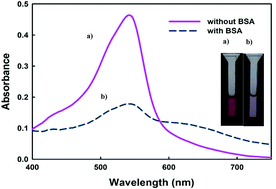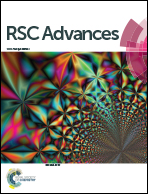A time-insensitive colorimetric sensor for the determination of total protein†
Abstract
Quantification of protein concentration is clinically important and especially in low concentration is of great significance. UV/vis absorbance spectrometry is the routinely used measurement method for protein quantization. However, most of the reported methods tend to overestimation, and more critically, depend highly on the timing, protein variation and suffer from interference in the measurements. Here, we report a simple, time-insensitive and superior sensitive method based on the binding of a new cationic cyanine dye with BSA. Both UV/vis spectrophotometry and image analysis techniques were used as a detection system. Optimum conditions were investigated by the experimental design method. This method is more convenient because it allows for UV spectroscopy measurements in time durations of >25 min. Two linear ranges for BSA are 22.00–112.00 nM and 0.43–4.10 μM and the limit of detection is 6.25 nM. The relative standard deviation of six replicate measurements is 2.33% for 2.50 μM BSA. This method, which responds to total protein, is simple, practical, and relatively free of interference from coexisting substances. It was successfully applied to the determination of protein in urine samples.


 Please wait while we load your content...
Please wait while we load your content...